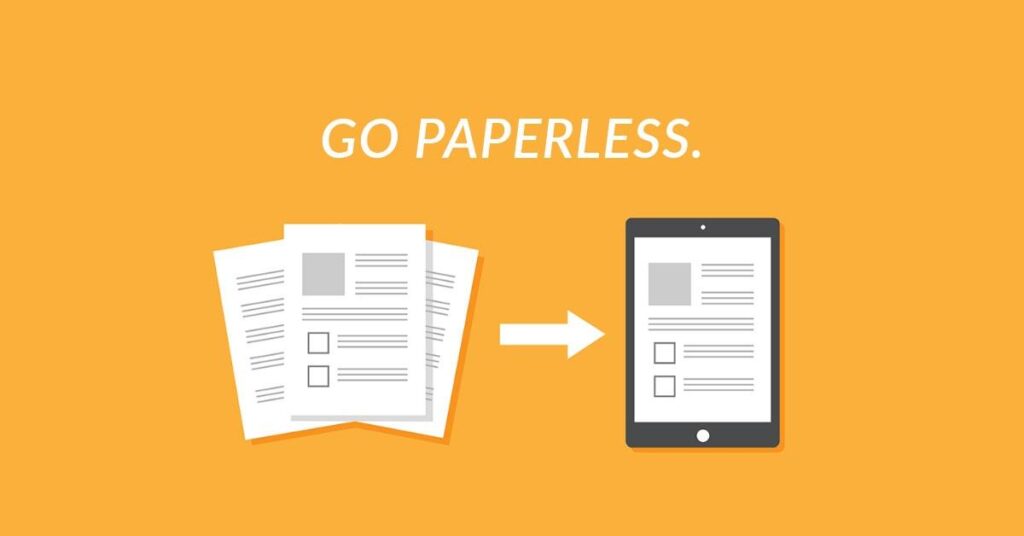The Future of Document Management: A Guide to Going Paperless
We’re living in a remarkable time where information is at our fingertips, flowing freely and unhindered by the barriers of the past. Remember when paperwork was king, file cabinets were stuffed with documents, and every signature required a pen and paper? Those days are fast becoming history. Instead, digital files, effortlessly accessible and sharable, have taken centre stage. This shift is happening everywhere, from personal files on our computers to massive corporate systems. And it’s not just a trend; it’s a movement fueled by environmental concerns, a desire for efficiency, a need for more space, and the lightning-fast pace of our digital lives.
But let’s be clear, going paperless is more than just swapping paper for pixels. It’s a whole new way of thinking about information. It’s not about leaving behind old habits; it’s about embracing new ones that connect us in ways we’ve never been connected before. It’s a way to break free from the old rules and let technology do the heavy lifting.
In this article, we’re diving into what it means to go paperless. We’ll look at what’s driving this movement, the tools that are making it happen, and some of the bumps in the road that you might face along the way.
The Current State of Document Management
The traditional approach to document management, characterised by large file cabinets and manual filing, is giving way to digital methods. The new landscape is defined by swift access, space efficiency, and environmental consciousness. Desks are now clutter-free, with documents stored securely in digital formats, ready for instant retrieval.
This transformation, although filled with promises, involves intricate procedures. The shift requires businesses to embrace innovative technologies and adopt new methods of information management. Understanding, training, and proper implementation are crucial to transition successfully.
As the digital age advances, the urgency to replace paper with pixels grows stronger, shaping not only modern businesses but also the way individuals manage documents.
The Importance of Going Paperless
The paperless movement is a response to both environmental and operational needs. Eliminating paper consumption contributes to preserving natural resources and reducing waste, aligning with global sustainability goals.
In operational terms, going paperless translates into streamlined processes, cost savings, and instant access to data. It enhances organisational agility, enabling quick decision-making and efficient collaborations.
The decision to go paperless extends beyond the organisation; it’s a societal shift toward a more responsible, effective, and future-ready approach to managing information. Every step toward paperless document management is a stride toward a more responsive and sustainable world.
Tools and Technologies Enabling Paperless Operations
The road to a paperless office is paved with innovative tools and technologies. Cloud-based storage systems enable secure, anywhere access to documents, fostering collaboration and organisation. Digital signature platforms streamline approvals and agreements without the need for physical paper, while project management tools facilitate real-time collaboration, keeping track of tasks and deadlines. Integrated communication tools connect teams, whether they’re in the same building or across the globe, promoting seamless interaction without reliance on printed materials. Together, these technologies knit a powerful network that makes the paperless paradigm not only possible but highly efficient and engaging.
But one tool that’s often overlooked is the PDF compressor. By allowing users to compress PDF files, it makes document storage more efficient and accessible.
Imagine sending a large file over email or storing years of documents on a server. Without the ability to use a PDF compress tool, these tasks would be cumbersome and time-consuming. A PDF compressor is more than just a handy tool; it’s an essential part of modern document management. By making documents more manageable and shareable, it helps to foster collaboration and efficiency.
Challenges and Solutions in Transitioning to Paperless
Going paperless, while promising, involves several challenges. Concerns about security, user adaptability, data integrity, and investment costs often arise. These challenges, although substantial, are surmountable with strategic planning and execution.
By identifying potential obstacles, devising clear strategies, and seeking expertise when needed, the transition can be smooth and effective. Regular evaluations, adjustments, and support further ensure success.
The journey may seem daunting, but with determination and the right approach, the paperless world is within reach, full of potential and opportunities.
Implementing Security and Compliance in a Paperless World
In the digital domain, security and compliance stand paramount. Ensuring data protection, adhering to legal requirements, and maintaining ethical standards are central to successful paperless document management.
A robust security framework, ongoing audits, encryption, and well-defined policies ensure that digital documents remain secure. Staying updated on regulatory changes and implementing necessary measures maintains compliance.
Balancing accessibility and security is challenging but critical in a paperless environment. Diligent efforts, foresight, and continuous monitoring create a fortress that guards digital assets without hampering their usability.
How to Start Your Paperless Journey
Initiating a paperless journey begins with a comprehensive assessment of current practices, followed by identifying areas for improvement. Researching available tools, including vital technologies like PDF compressors, aligns the strategy with specific needs.
Careful planning, gradual implementation, training, and ongoing monitoring make the transition seamless. Recognising successes, learning from setbacks, and continuous improvement transform the journey into a rewarding experience.
The road to paperless is a path filled with growth, efficiency, and adaptability. It’s a journey toward a modern, responsive, and sustainable future in document management.
What The Future Has In Store
The digital revolution has redefined how we manage and interact with documents. The transition from paper-based to paperless systems symbolises more than a technological shift; it represents a fundamental transformation in our approach to information. The realms of environmental sustainability, operational efficiency, global connectedness, and technological innovation converge to create a dynamic landscape where paper is replaced by pixels. This landscape constantly evolves, with new tools and technologies emerging to facilitate this paperless paradigm.
As we’ve explored in this guide, the decision to go paperless is multifaceted. It’s a response to the urgency of preserving natural resources and aligning with global sustainability. It’s an acknowledgement of the operational benefits that come with streamlined processes, instant data access, and cost savings. This transformation is possible because of tools like cloud storage, digital signatures, project management, integrated communication platforms, and essential technologies like PDF compressors. They knit a powerful network that fosters collaboration, efficiency, and engagement.
Yet, the journey is not without its challenges. Concerns about security, user adaptability, data integrity, and investment costs are real and substantial. However, with careful planning, strategic execution, continuous monitoring, and the right balance between accessibility and security, these challenges can be overcome. The road may be complex, but the destination is promising, filled with opportunities for growth, adaptability, and innovation.
Summing Up
In the face of a rapidly changing world, the move towards paperless document management is no longer an option; it’s an imperative. It’s a step towards a more responsible, effective, and future-ready approach to managing information. It’s about embracing change, not fearing it; about leveraging technology, not being limited by it. Whether you are an individual looking to manage personal documents or an organisation aiming to overhaul its information management system, the time to embark on this paperless journey is now. The future of document management is here, and it’s digital, dynamic, and ready for you to participate in. Join the movement, embrace the future, and let the paperless transformation be a testament to our age’s ingenuity, responsiveness, and unbounded potential.






